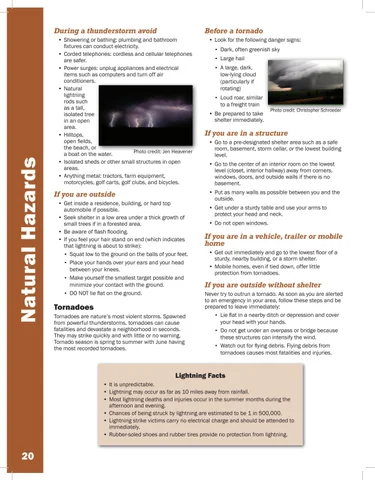Natural Hazards
During a thunderstorm avoid
Before a tornado
• Showering or bathing: plumbing and bathroom fixtures can conduct electricity. • Corded telephones: cordless and cellular telephones are safer. • Power surges: unplug appliances and electrical items such as computers and turn off air conditioners. • Natural lightning rods such as a tall, isolated tree in an open area. • Hilltops, open fields, the beach, or Photo credit: Jen Heavener a boat on the water. • Isolated sheds or other small structures in open areas. • Anything metal: tractors, farm equipment, motorcycles, golf carts, golf clubs, and bicycles.
If you are outside • Get inside a residence, building, or hard top automobile if possible. • Seek shelter in a low area under a thick growth of small trees if in a forested area. • Be aware of flash flooding. • If you feel your hair stand on end (which indicates that lightning is about to strike): ▪ Squat low to the ground on the balls of your feet. ▪ Place your hands over your ears and your head between your knees. ▪ Make yourself the smallest target possible and minimize your contact with the ground. ▪ DO NOT lie flat on the ground.
Tornadoes Tornadoes are nature’s most violent storms. Spawned from powerful thunderstorms, tornadoes can cause fatalities and devastate a neighborhood in seconds. They may strike quickly and with little or no warning. Tornado season is spring to summer with June having the most recorded tornadoes.
• Look for the following danger signs: ▪ Dark, often greenish sky ▪ Large hail ▪ A large, dark, low-lying cloud (particularly if rotating) ▪ Loud roar, similar to a freight train • Be prepared to take shelter immediately.
Photo credit: Christopher Schroeder
If you are in a structure • Go to a pre-designated shelter area such as a safe room, basement, storm cellar, or the lowest building level. • Go to the center of an interior room on the lowest level (closet, interior hallway) away from corners, windows, doors, and outside walls if there is no basement. • Put as many walls as possible between you and the outside. • Get under a sturdy table and use your arms to protect your head and neck. • Do not open windows.
If you are in a vehicle, trailer or mobile home • Get out immediately and go to the lowest floor of a sturdy, nearby building, or a storm shelter. • Mobile homes, even if tied down, offer little protection from tornadoes.
If you are outside without shelter Never try to outrun a tornado. As soon as you are alerted to an emergency in your area, follow these steps and be prepared to leave immediately: ▪ Lie flat in a nearby ditch or depression and cover your head with your hands. ▪ Do not get under an overpass or bridge because these structures can intensify the wind. ▪ Watch out for flying debris. Flying debris from tornadoes causes most fatalities and injuries.
Lightning Facts • It is unpredictable. • Lightning may occur as far as 10 miles away from rainfall. • Most lightning deaths and injuries occur in the summer months during the afternoon and evening. • Chances of being struck by lightning are estimated to be 1 in 500,000. • Lightning strike victims carry no electrical charge and should be attended to immediately. • Rubber-soled shoes and rubber tires provide no protection from lightning.
20














